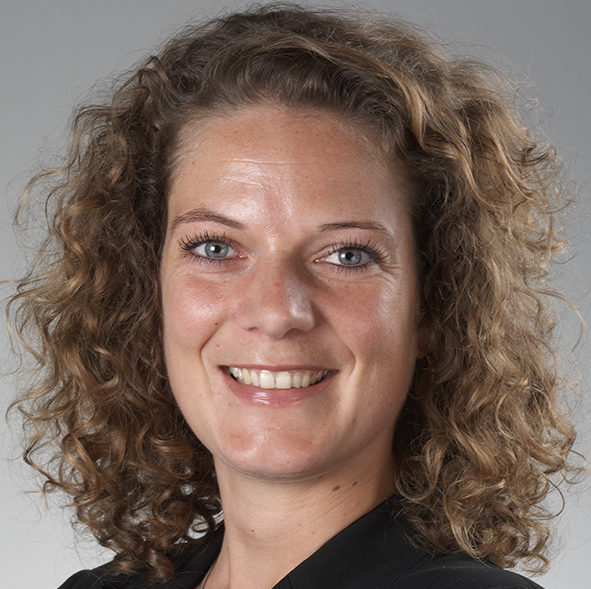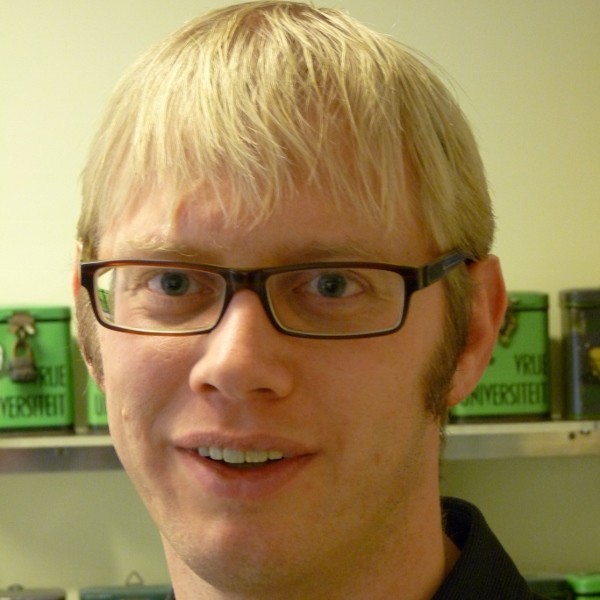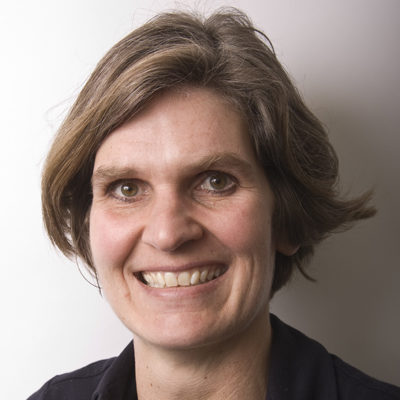Idsart Kingma

Vrije Universiteit Amsterdam
Van der Boechorststraat 9, 1081 BT Amsterdam
room A434
+31 20 59 88501
General Interests
My main research interest is spine loading and effects of measures to reduce such loading, e.g. by ergonomics measures, improving lifting technique, and use of exoskeletons. In addition, I am interested in the cause, development and treatment of spine disorders. Another part of my research is focusing on sports biomechanics and the risk of sports injuries such as ankle sprains and knee anterior cruciate ligament ruptures.
Achievements
I have supervised 11 PhD students that have graduated, and at present I am supervising 9 PhD students. Of those students, 6 will graduate at the VU. I have (co-) authored over 150 papers in international scientific journals. I serve on the editorial boards of Journal of Electromyography and Kinesiology, and Journal of Biomechanics.
Current Research
My current research focus is in the development and testing of spine supporting exoskeletons. In five PhD projects, we are working on development of trunk and head support for patients with muscular dystrophy (Symbionics, TTW perspectief); development of trunk support for prevention and rehabilitation of low back pain (EU program SPEXOR, TTW perspectief program Wearable Robotics, and a collaborative project with TNO). Furthermore, in collaboration with a soccer club, the Dutch soccer association and a company I work on lower limb stability in relation to injury.
Résumé
I obtained my PhD in 1998 from the Vrije Universiteit Amsterdam, based on the thesis entitled: ‘Challenging gravity: the mechanics of lifting’. My current position is associate professor at the Department of Human Movement Sciences. As a co-applicant I received grants from NWO (MaGw, 2003 and 2009) from the EU (Spexor, 2015) and TTW (Pespectief program Wearable Robotics ,2018).
Personal news…
- There are currently no news available
Corporate news…
- There are currently no news available
Research…
Balance testing
In this project we aim to develop outcome measures of static single leg balance tests and dynamic single leg landing tasks to evaluate sensorimotor control, more specifically the ability of an individual to stabilize posture, suitable for large-scale assessment of performance and injury risk in athletes, and for evaluation of recovery after injuryBiomechanics of ballistic whole-body movement in elite athletes
In this project we aim to understand the motor control strategy during ballistic sports actions and the function of the joints and muscles involved. Specifically, we investigate the full-body 3D kinematics and kinetics of top level hockey players during performance of the drag-push, and the diving save of top level goal keepers in football. Results ...Markers of progression and early predictors in Parkinson’s disease
Parkinson’s disease (PD) is a common condition in elderly. gait and postural control mechanisms are progressively affected in patients with PD. We use a single body-worn inertial sensor to analyze short episodes of gait. We extract signal features to objectify and understand gait changes in patients with PD, and to find markers for early detection ...Spexor: The effects of a spinal exoskeleton on biomechanics, performance, and user-satisfaction in healthy people and low back pain patients
In a European consortium, we are working on development of exoskeleton systems aiming at reduction of back loading in the context of prevention of low-back pain and rehabilitation/training of low-back pain patients. We aim to formulate requirements based on known risk factors for low-back pain. Furthermore, we perform iterative evaluations of prototypes in healthy subjects ...Spine Biomechanics
Understanding biomechanical behavior of the spine under short term and long term loading is vital to comprehend the control over spine movement, unravel injury mechanisms and to understand intervertebral disc degeneration. In addition, this work is needed to improve surgical interventions related to, e.g., treatment of scoliosis, and for effective design of new therapeutic interventions, ...Symbionics: Co-adaptive support of trunk and head in relation to arm movements
Patients with pareses such as Duchenne Muscle Dystrophy gradually lose control of their muscles and at some point during development of the disease they are unable to stabilize and move their trunk and head. This impedes not just head and trunk function but also arm function. In this project, we aim to develop passive and ...Wearable Robotics: Exo-Aid for augmenting human physical capacities
Patients with pareses such as Duchenne Muscle Dystrophy gradually lose control of their muscles and at some point during development of the disease they are unable to stabilize and move their trunk and head. This impedes not just head and trunk function but also arm function. In this project, we aim to develop passive and ...
Network…
- No activities at the moment.
Excerpts of scientific work
- EU Vibration Limit Values May Be Too Strict for Evaluating the Effect of Impact Loading on the Lower Back During Horse Riding
EU Vibration Limit Values May Be Too Strict for Evaluating the Effect of Impact Loading on the Lower Back During Horse Riding
Smit, N. A., Bos, J. E., van Dieën, J. H. & Kingma, I., Jun 2025, In: Vibration. 8, 2, p. 1-11 11 p., 26.Research output: Contribution to Journal › Article › Academic › peer-review
- Trunk angular velocity: A convenient, valid and responsive substitute for force plate-based measures of dynamic postural stability
Trunk angular velocity: A convenient, valid and responsive substitute for force plate-based measures of dynamic postural stability
Vos, L. A., Prins, M. R., Plompen, E., van Dieën, J. H. & Kingma, I., May 2025, In: PLoS ONE. 20, 5, p. 1-13 13 p., e0323993.Research output: Contribution to Journal › Article › Academic › peer-review
- Predictive potential of circular walking in prodromal Parkinson's disease
Predictive potential of circular walking in prodromal Parkinson's disease
Micó-Amigo, M. E., Kingma, I., Heinzel, S., Solbrig, S., Hobert, M. A., Elshehabi, M., Brockmann, K., Metzger, F. G., van Lummel, R. C., Berg, D., Maetzler, W. & van Dieën, J. H., Feb 2025, In: Journal of Parkinson's disease. 15, 1, p. 140-153 14 p.Research output: Contribution to Journal › Article › Academic › peer-review
- Can intermittent changes in trunk extensor muscle length delay muscle fatigue development?
Can intermittent changes in trunk extensor muscle length delay muscle fatigue development?
Brouwer, N. P., Kingma, I., van Dijk, W. & van Dieën, J. H., Jan 2024, In: Journal of Biomechanics. 162, p. 1-9 9 p., 111881.Research output: Contribution to Journal › Article › Academic › peer-review
- The effect of active exoskeleton support with different lumbar-to-hip support ratios on spinal musculoskeletal loading and lumbar kinematics during lifting
The effect of active exoskeleton support with different lumbar-to-hip support ratios on spinal musculoskeletal loading and lumbar kinematics during lifting
Brouwer, N. P., Tabasi, A., Hu, F., Kingma, I., Dijk, W. V., Refai, M. I. M., Kooij, H. V. D. & Dieën, J. H. V., 2024, In: Wearable Technologies. 5, p. 1-19 19 p., e25.Research output: Contribution to Journal › Article › Academic › peer-review
- The effect of back muscle fatigue on EMG and kinematics based estimation of low-back loads and active moments during manual lifting tasks
The effect of back muscle fatigue on EMG and kinematics based estimation of low-back loads and active moments during manual lifting tasks
Tabasi, A., Brouwer, N. P., Kingma, I., van Dijk, W., de Looze, M. P., Moya-Esteban, A., Kooij, H. V. D. & van Dieën, J. H., Dec 2023, In: Journal of Electromyography and Kinesiology. 73, p. 1-8 8 p., 102815.Research output: Contribution to Journal › Article › Academic › peer-review
- Trunk extensor muscle endurance and its relationship to action potential conduction velocity and spectral parameters estimated using high-density electromyography
Trunk extensor muscle endurance and its relationship to action potential conduction velocity and spectral parameters estimated using high-density electromyography
Brouwer, N. P., Tabasi, A., Kingma, I., Stegeman, D. F., van Dijk, W., Moya-Esteban, A., Sartori, M. & van Dieën, J. H., Dec 2023, In: Journal of Electromyography and Kinesiology. 73, p. 1-8 8 p., 102830.Research output: Contribution to Journal › Article › Academic › peer-review
- Exposure to inclined trunk postures in surgical staff
Exposure to inclined trunk postures in surgical staff
Brouwer, N. P., Kingma, I., van Dijk, W. & van Dieën, J. H., Dec 2023, In: Journal of Biomechanics. 161, p. 1-6 6 p., 111833.Research output: Contribution to Journal › Article › Academic › peer-review
- Development of a real time estimation method of L5S1 moments in occupational lifting
Development of a real time estimation method of L5S1 moments in occupational lifting
Peters, S. L. A., Tabasi, A., Kingma, I., van Dijk, W. & van Dieën, J. H., Jan 2023, In: Journal of Biomechanics. 146, p. 1-8 8 p., 111417.Research output: Contribution to Journal › Article › Academic › peer-review
- Low back muscle action potential conduction velocity estimated using high-density electromyography
Low back muscle action potential conduction velocity estimated using high-density electromyography
Brouwer, N. P., Tabasi, A., Kingma, I., Stegeman, D. F., van Dijk, W., Moya-Esteban, A., Sartori, M. & van Dieën, J. H., Oct 2022, In: Journal of Electromyography and Kinesiology. 66, p. 1-9 9 p., 102679.Research output: Contribution to Journal › Article › Academic › peer-review
- Can stabilization analysis following a single leg drop jump be compared between young and middle-aged adults
Can stabilization analysis following a single leg drop jump be compared between young and middle-aged adults
Hayek, R., Gottlieb, U., Gutman, I., Kingma, I. & Springer, S., Oct 2022, In: Journal of Biomechanics. 143, p. 1-8 8 p., 111269.Research output: Contribution to Journal › Article › Academic › peer-review
- Data-driven strength and conditioning, and technical training programs for goalkeeper's diving save in football
Data-driven strength and conditioning, and technical training programs for goalkeeper's diving save in football
Ibrahim, R., de Boode, V., Kingma, I. & van Dieën, J. H., 27 Jul 2022, (E-pub ahead of print) In: Sports Biomechanics. 13 p.Research output: Contribution to Journal › Article › Academic › peer-review
- The effect of cryotherapy on postural stabilization assessed by standardized horizontal perturbations of a movable platform
The effect of cryotherapy on postural stabilization assessed by standardized horizontal perturbations of a movable platform
Beelen, P. E., van Dieën, J. H., Prins, M. R., Nolte, P. A. & Kingma, I., May 2022, In: Gait and Posture. 94, p. 32-38 7 p.Research output: Contribution to Journal › Article › Academic › peer-review
- Contribution of arm movements to balance recovery after tripping in older adults
Contribution of arm movements to balance recovery after tripping in older adults
Bruijn, S. M., Sloot, L. H., Kingma, I. & Pijnappels, M., Mar 2022, In: Journal of Biomechanics. 133, p. 1-4 4 p., 110981.Research output: Contribution to Journal › Article › Academic › peer-review
- Training potential of visual feedback to improve dynamic postural stability
Training potential of visual feedback to improve dynamic postural stability
Vos, L. A., Prins, M. R. & Kingma, I., Feb 2022, In: Gait and Posture. 92, p. 243-248 6 p.Research output: Contribution to Journal › Article › Academic › peer-review
- The Effects of Intermittent Trunk Flexion With and Without Support on Sitting Balance in Young Adults
The Effects of Intermittent Trunk Flexion With and Without Support on Sitting Balance in Young Adults
Voglar, M., Kozinc, Ž., Kingma, I., van Dieën, J. H. & Šarabon, N., 2022, In: Frontiers in Human Neuroscience. 16, p. 1-8 8 p., 868153.Research output: Contribution to Journal › Article › Academic › peer-review
- Optimizing calibration procedure to train a regression‐based prediction model of actively generated lumbar muscle moments for exoskeleton control
Optimizing calibration procedure to train a regression‐based prediction model of actively generated lumbar muscle moments for exoskeleton control
Tabasi, A., Lazzaroni, M., Brouwer, N. P., Kingma, I., van Dijk, W., de Looze, M. P., Toxiri, S., Ortiz, J. & van Dieën, J. H., 1 Jan 2022, In: Sensors (Basel, Switzerland). 22, 1, p. 1-14 14 p., 87.Research output: Contribution to Journal › Article › Academic › peer-review
- A novel passive neck orthosis for patients with degenerative muscle diseases: Development & evaluation
A novel passive neck orthosis for patients with degenerative muscle diseases: Development & evaluation
Mahmood, M. N., Tabasi, A., Kingma, I. & van Dieën, J. H., Apr 2021, In: Journal of Electromyography and Kinesiology. 57, p. 1-8 8 p., 102515.Research output: Contribution to Journal › Article › Academic › peer-review
- A meta-analysis and systematic review of changes in joint position sense and static standing balance in patients with whiplashassociated disorder
A meta-analysis and systematic review of changes in joint position sense and static standing balance in patients with whiplashassociated disorder
Mazaheri, M., Abichandani, D., Kingma, I., Treleaven, J. & Falla, D., Apr 2021, In: PLoS ONE. 16, 4, p. 1-28 28 p., e0249659.Research output: Contribution to Journal › Article › Academic › peer-review
- Reliability of a novel dynamic test of postural stability in high-level soccer players
Reliability of a novel dynamic test of postural stability in high-level soccer players
Beelen, P. E., Okhuijsen, R., Prins, M. R., Huurnink, A., Hordijk, T., Kruiswijk, C., Goedhart, E. A., van der Wurff, P., Nolte, P. A., van Dieën, J. H. & Kingma, I., Apr 2021, In: Heliyon. 7, 4, p. 1-8 8 p., e06647.Research output: Contribution to Journal › Article › Academic › peer-review
- The effect of foot type, body length and mass on postural stability
The effect of foot type, body length and mass on postural stability
Beelen, P. E., Kingma, I., Nolte, P. A. & van Dieën, J. H., Sept 2020, In: Gait and Posture. 81, p. 241-246 6 p.Research output: Contribution to Journal › Article › Academic › peer-review
- Evaluation of an acceleration-based assistive strategy to control a back-support exoskeleton for manual material handling
Evaluation of an acceleration-based assistive strategy to control a back-support exoskeleton for manual material handling
Lazzaroni, M., Tabasi, A., Toxiri, S., Caldwell, D. G., De Momi, E., van Dijk, W., de Looze, M., Kingma, I., van Dieen, J. & Ortiz, J., 31 Aug 2020, In: Wearable Technologies. 1, p. 1-16 16 p., e9.Research output: Contribution to Journal › Article › Academic › peer-review
- Biomechanical evaluation of a new passive back support exoskeleton
Biomechanical evaluation of a new passive back support exoskeleton
Koopman, A. S., Näf, M., Baltrusch, S. J., Kingma, I., Rodriguez-Guerrero, C., Babič, J., de Looze, M. P. & van Dieën, J. H., 22 May 2020, In: Journal of Biomechanics. 105, p. 1-8 8 p., 109795.Research output: Contribution to Journal › Article › Academic › peer-review
- Biomechanical properties in motion of lumbar spines with degenerative scoliosis
Biomechanical properties in motion of lumbar spines with degenerative scoliosis
Rustenburg, C. M. E., Kingma, I., Holewijn, R. M., Faraj, S. S. A., van der Veen, A., Bisschop, A., de Kleuver, M. & Emanuel, K. S., 26 Mar 2020, In: Journal of Biomechanics. 102, p. 1-8 8 p., 109495.Research output: Contribution to Journal › Article › Academic › peer-review
- Validation of a wearable system for 3D ambulatory L5/S1 moment assessment during manual lifting using instrumented shoes and an inertial sensor suit
Validation of a wearable system for 3D ambulatory L5/S1 moment assessment during manual lifting using instrumented shoes and an inertial sensor suit
Faber, G. S., Kingma, I., Chang, C. C., Dennerlein, J. T. & van Dieën, J. H., 26 Mar 2020, In: Journal of Biomechanics. 102, p. 1-11 11 p., 109671.Research output: Contribution to Journal › Article › Academic › peer-review
- Real-time feedback to reduce low-back load in lifting and lowering
Real-time feedback to reduce low-back load in lifting and lowering
Punt, M., Nematimoez, M., van Dieën, J. H. & Kingma, I., 26 Mar 2020, In: Journal of Biomechanics. 102, p. 1-7 7 p., 109513.Research output: Contribution to Journal › Article › Academic › peer-review
- Selecting the appropriate input variables in a regression approach to estimate actively generated muscle moments around L5/S1 for exoskeleton control
Selecting the appropriate input variables in a regression approach to estimate actively generated muscle moments around L5/S1 for exoskeleton control
Tabasi, A., Kingma, I., de Looze, M. P., van Dijk, W., Koopman, A. S. & van Dieën, J. H., 26 Mar 2020, In: Journal of Biomechanics. 102, p. 109650 109650.Research output: Contribution to Journal › Article › Academic › peer-review
- Effects of a passive back exoskeleton on the mechanical loading of the low-back during symmetric lifting
Effects of a passive back exoskeleton on the mechanical loading of the low-back during symmetric lifting
Koopman, A. S., Kingma, I., de Looze, M. P. & van Dieën, J. H., 26 Mar 2020, In: Journal of Biomechanics. 102, p. 1-7 7 p., 109486.Research output: Contribution to Journal › Article › Academic › peer-review
- Age-Matched Z-Scores for Longitudinal Monitoring of Center of Pressure Speed in Single-Leg Stance Performance in Elite Male Youth Soccer Players
Age-Matched Z-Scores for Longitudinal Monitoring of Center of Pressure Speed in Single-Leg Stance Performance in Elite Male Youth Soccer Players
Huurnink, A., Fransz, D. P., de Boode, V. A., Kingma, I. & van Dieën, J. H., Feb 2020, In: Journal of Strength and Conditioning Research. 34, 2, p. 495-505 11 p.Research output: Contribution to Journal › Article › Academic › peer-review
- Angular Velocity, Moment, and Power Analysis of the Ankle, Knee, and Hip Joints in the Goalkeeper's Diving Save in Football
Angular Velocity, Moment, and Power Analysis of the Ankle, Knee, and Hip Joints in the Goalkeeper's Diving Save in Football
Ibrahim, R., Kingma, I., de Boode, V., Faber, G. S. & van Dieën, J. H., Feb 2020, In: Frontiers in sports and active living. 2, February, p. 1-9 9 p., 13.Research output: Contribution to Journal › Article › Academic › peer-review
- Patients with spinal muscular atrophy use high percentages of trunk muscle capacity to perform seated tasks
Patients with spinal muscular atrophy use high percentages of trunk muscle capacity to perform seated tasks
Peeters, L. H. C., Janssen, M. M. H. P., Kingma, I., van Dieën, J. H. & de Groot, I. J. M., Dec 2019, In: American Journal of Physical Medicine and Rehabilitation. 98, 12, p. 1110-1117 8 p.Research output: Contribution to Journal › Article › Academic › peer-review
- The assessment of single-leg drop jump landing performance by means of ground reaction forces: A methodological study
The assessment of single-leg drop jump landing performance by means of ground reaction forces: A methodological study
Huurnink, A., Fransz, D. P., Kingma, I., de Boode, V. A. & Dieën, J. H. V., 1 Sept 2019, In: Gait and Posture. 73, p. 80-85 6 p.Research output: Contribution to Journal › Article › Academic › peer-review
- The effect of control strategies for an active back-support exoskeleton on spine loading and kinematics during lifting
The effect of control strategies for an active back-support exoskeleton on spine loading and kinematics during lifting
Koopman, A. S., Toxiri, S., Power, V., Kingma, I., van Dieën, J. H., Ortiz, J. & de Looze, M. P., 25 Jun 2019, In: Journal of Biomechanics. 91, p. 14-22 9 p.Research output: Contribution to Journal › Article › Academic › peer-review
- Dual vs. Single Tasking During Circular Walking: What Better Reflects Progression in Parkinson's Disease?
Dual vs. Single Tasking During Circular Walking: What Better Reflects Progression in Parkinson's Disease?
Micó-Amigo, M. E., Kingma, I., Heinzel, S., Nussbaum, S., Heger, T., van Lummel, R. C., Berg, D., Maetzler, W. & van Dieën, J. H., 14 May 2019, In: Frontiers in Neurology. 10, May, p. 1-19 19 p., 372.Research output: Contribution to Journal › Article › Academic › peer-review
- The biomechanical effect of single-level laminectomy and posterior instrumentation on spinal stability in degenerative lumbar scoliosis: A human cadaveric study
The biomechanical effect of single-level laminectomy and posterior instrumentation on spinal stability in degenerative lumbar scoliosis: A human cadaveric study
Rustenburg, C. M. E., Faraj, S. S. A., Holewijn, R. M., Kingma, I., van Royen, B. J., Stadhouder, A. & Emanuel, K. S., May 2019, In: Neurosurgical Focus. 46, 5, p. 1-8 8 p., E15.Research output: Contribution to Journal › Article › Academic › peer-review
- Don't forget the trunk in Duchenne muscular dystrophy patients: More muscle weakness and compensation than expected
Don't forget the trunk in Duchenne muscular dystrophy patients: More muscle weakness and compensation than expected
Peeters, L. H. C., Kingma, I., Van Dieën, J. H. & De Groot, I. J. M., 27 Mar 2019, In: Journal of NeuroEngineering and Rehabilitation. 16, p. 1-10 10 p., 44.Research output: Contribution to Journal › Article › Academic › peer-review
- A prospective analysis of motion and deformity at the shoulder level in surgically treated adolescent idiopathic scoliosis
A prospective analysis of motion and deformity at the shoulder level in surgically treated adolescent idiopathic scoliosis
Holewijn, R. M., de Kleuver, M., Kingma, I. & Keijsers, N. L. W., Mar 2019, In: Gait and Posture. 69, p. 150-155 6 p.Research output: Contribution to Journal › Article › Academic › peer-review
- Potential markers of progression in idiopathic Parkinson’s disease derived from assessment of circular gait with a single body-fixed-sensor: A 5 year longitudinal study
Potential markers of progression in idiopathic Parkinson’s disease derived from assessment of circular gait with a single body-fixed-sensor: A 5 year longitudinal study
Micó-Amigo, M. E., Kingma, I., Heinzel, S., Rispens, S. M., Heger, T., Nussbaum, S., van Lummel, R. C., Berg, D., Maetzler, W. & van Dieën, J. H., 19 Feb 2019, In: Frontiers in Human Neuroscience. 13, FEBRUARY, p. 1-14 14 p., 59.Research output: Contribution to Journal › Article › Academic › peer-review
- Kinematic and kinetic analysis of the goalkeeper’s diving save in football
Kinematic and kinetic analysis of the goalkeeper’s diving save in football
Ibrahim, R., Kingma, I., de Boode, V. A., Faber, G. S. & van Dieën, J. H., 1 Feb 2019, In: Journal of Sports Sciences. 37, 3, p. 313-321 9 p.Research output: Contribution to Journal › Article › Academic › peer-review
- Effects of a passive exoskeleton on the mechanical loading of the low back in static holding tasks
Effects of a passive exoskeleton on the mechanical loading of the low back in static holding tasks
Koopman, A. S., Kingma, I., Faber, G. S., de Looze, M. P. & van Dieën, J. H., 23 Jan 2019, In: Journal of Biomechanics. 83, p. 97-103 7 p.Research output: Contribution to Journal › Article › Academic › peer-review
- Performance on a Single-Legged Drop-Jump Landing Test Is Related to Increased Risk of Lateral Ankle Sprains Among Male Elite Soccer Players: A 3-Year Prospective Cohort Study
Performance on a Single-Legged Drop-Jump Landing Test Is Related to Increased Risk of Lateral Ankle Sprains Among Male Elite Soccer Players: A 3-Year Prospective Cohort Study
Fransz, D. P., Huurnink, A., Kingma, I., de Boode, V. A., Heyligers, I. C. & van Dieën, J. H., 1 Dec 2018, In: The American journal of sports medicine. 46, 14, p. 3454-3462 9 p.Research output: Contribution to Journal › Article › Academic › peer-review
- Posterior spinal surgery for adolescent idiopathic scoliosis does not induce compensatory increases in distal adjacent segment motion: a prospective gait analysis study
Posterior spinal surgery for adolescent idiopathic scoliosis does not induce compensatory increases in distal adjacent segment motion: a prospective gait analysis study
Holewijn, R. M., Kingma, I., de Kleuver, M. & Keijsers, N. L. W., Dec 2018, In: The Spine Journal. 18, 12, p. 2213-2219 7 p.Research output: Contribution to Journal › Article › Academic › peer-review
- Early changes in the extracellular matrix of the degenerating intervertebral disc, assessed by Fourier transform infrared imaging
Early changes in the extracellular matrix of the degenerating intervertebral disc, assessed by Fourier transform infrared imaging
Emanuel, K. S., Mader, K. T., Peeters, M., Kingma, I., Rustenburg, C. M. E., Vergroesen, P. P. A., Sammon, C. & Smit, T. H., Oct 2018, In: Osteoarthritis and Cartilage. 26, 10, p. 1400-1408 9 p.Research output: Contribution to Journal › Article › Academic › peer-review
- Predicting the influence of hip and lumbar flexibility on lifting motions using optimal control
Predicting the influence of hip and lumbar flexibility on lifting motions using optimal control
Sreenivasa, M., Millard, M., Kingma, I., van Dieën, J. H. & Mombaur, K., 10 Sept 2018, In: Journal of Biomechanics. 78, p. 118-125 8 p.Research output: Contribution to Journal › Article › Academic › peer-review
- Changes in intervertebral disk mechanical behavior during early degeneration
Changes in intervertebral disk mechanical behavior during early degeneration
Paul, C. P. L., Emanuel, K. S., Kingma, I., Van Der Veen, A. J., Holewijn, R. M., Vergroesen, P. P. A., Van De Ven, P. M., Mullender, M. G., Helder, M. N. & Smit, T. H., Sept 2018, In: Journal of Biomechanical Engineering. 140, 9, p. 1-9 9 p., 091008.Research output: Contribution to Journal › Article › Academic › peer-review
- Trunk, head and pelvis interactions in healthy children when performing seated daily arm tasks
Trunk, head and pelvis interactions in healthy children when performing seated daily arm tasks
Peeters, L. H. C., Kingma, I., Faber, G. S., van Dieën, J. H. & de Groot, I. J. M., Jul 2018, In: Experimental Brain Research. 236, 7, p. 2023-2036 14 p.Research output: Contribution to Journal › Article › Academic › peer-review
- Osmosis and viscoelasticity both contribute to time-dependent behaviour of the intervertebral disc under compressive load: A caprine in vitro study
Osmosis and viscoelasticity both contribute to time-dependent behaviour of the intervertebral disc under compressive load: A caprine in vitro study
Emanuel, K. S., van der Veen, A. J., Rustenburg, C. M. E., Smit, T. H. & Kingma, I., 21 Mar 2018, In: Journal of Biomechanics. 70, p. 10-15 6 p.Research output: Contribution to Journal › Article › Academic › peer-review
- Coupled motions in human and porcine thoracic and lumbar spines
Coupled motions in human and porcine thoracic and lumbar spines
Kingma, I., Busscher, I., van der Veen, A. J., Verkerke, G. J., Veldhuizen, A. G., Homminga, J. & van Dieën, J. H., 21 Mar 2018, In: Journal of Biomechanics. 70, p. 51-58 8 p.Research output: Contribution to Journal › Article › Academic › peer-review
- Development and evaluation of a passive trunk support system for Duchenne muscular dystrophy patients
Development and evaluation of a passive trunk support system for Duchenne muscular dystrophy patients
Mahmood, M. N., Peeters, L. H. C., Paalman, M., Verkerke, G. J., Kingma, I. & Van Dieën, J. H., 14 Mar 2018, In: Journal of NeuroEngineering and Rehabilitation. 15, 1, 22.Research output: Contribution to Journal › Article › Academic › peer-review
- The cyclo-oxygenase-dependent regulation of rabbit vein contraction: Evidence for a prostaglandin E2-mediated relaxation
The cyclo-oxygenase-dependent regulation of rabbit vein contraction: Evidence for a prostaglandin E2-mediated relaxation
Kingma, I., Toussaint, H. M., Commissaris, D. A. C. M. & Savelsbergh, G. J. P., 27 Jan 1999, In: British Journal of Pharmacology. 126, 1, p. 35-44 10 p.Research output: Contribution to Journal › Article › Academic › peer-review
Excerpts of scientific work
- Challenging gravity: the mechanics of lifting
Challenging gravity: the mechanics of lifting
Kingma, I., 1998, Amstelveen: Idsart Kingma. 168 p.Research output: PhD Thesis › PhD-Thesis - Research and graduation internal










